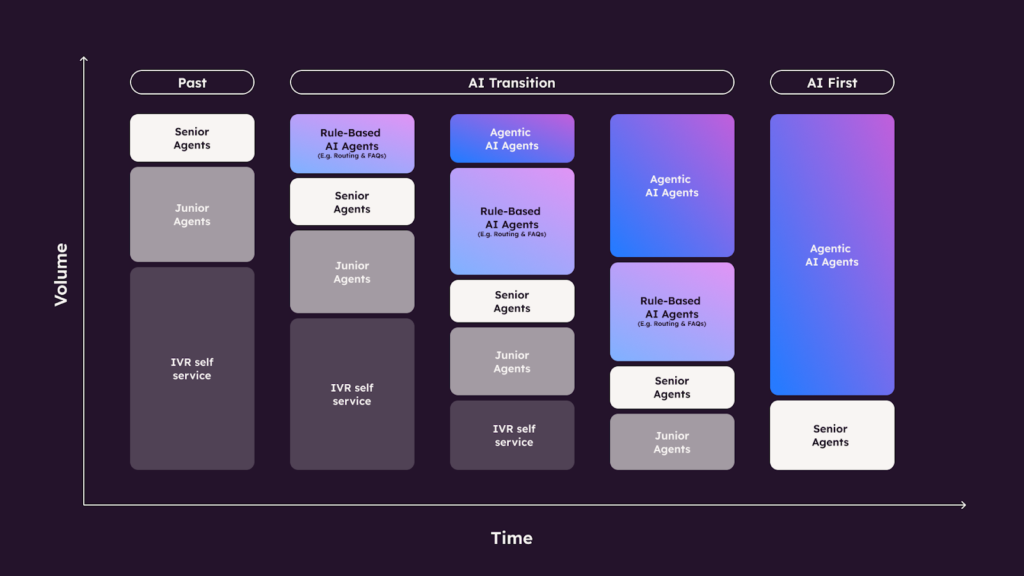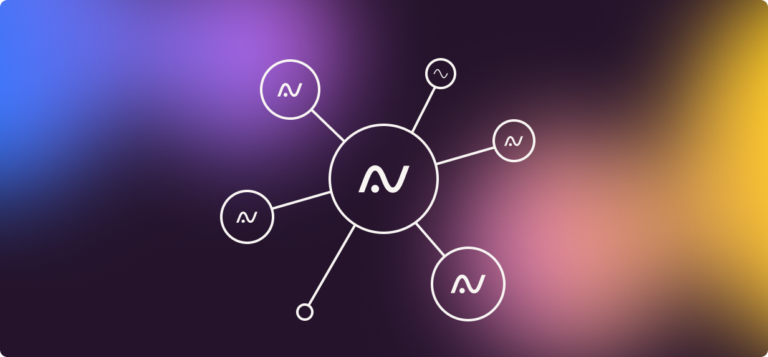It’s well known that contact centers often struggle to keep pace with surges in demand. In the future, however, they will be powered by a seamless collaboration between human agents and a team of AI agents. These AI agents will enable teams to handle customer needs more effectively, scaling on demand and delivering exceptional customer experiences.
As AI-powered contact centers reduce wait times and deliver faster, more personalized service, customers expect this standard. This shift doesn’t just transform organizations—it redefines customers’ expectations. Companies that lag behind risk falling short of these new expectations, as seamless service becomes the baseline for customer satisfaction in an AI-driven world.
Leaders’ adoption of customer service innovation is the “new” normal

Over the years, we’ve observed a clear and distinct progression in how customer service leaders adopt and integrate new technologies, a journey that can be categorized into three key phases.
Phase one: When IVR ruled customer service
IVR (interactive-voice-response) technology was introduced in the 1970s, leveraging touch-tone telephone keypads to enable customers to navigate basic menu options. IVR technology brought significant efficiency gains by automating simple routing tasks and eliminating wait times for basic queries. But we all know the drawbacks of classic IVRs… the simplicity of this type of routing often creates challenges, as it is unable to handle complex needs, leading to frustration when customers need to solve more intricate situations.
Phase two: Transitioning from the past to the AI era
The introduction and expansion of rule-based AI agents for tasks such as routing and answering FAQs marked a major advancement in customer service. At the beginning of the phase, simple rule-based processes were integrated with IVR systems and human intervention to manage customer inquiries more effectively.
Subsequently, we saw the emergence of generative AI-driven, autonomous AI agents, marking a key step forward by adding more dynamic and sophisticated capabilities to the existing rule-based framework. This represented a step-function change, as even the inclusion of a few AI agents had an exponential impact on service quality and operational efficiency. This phase represents a crucial inflection point where AI’s role evolves from augmenting human support to independently managing increasingly complex tasks.
Phase three: AI-first customer service is here
Over time, we believe that the rise of autonomous AI agents will mark a new era in customer service, further reducing dependence on traditional rule-based systems and junior experts. As technology continues to advance, these agents will gain increasingly sophisticated capabilities. To make this shift possible, businesses need deterministic agents with strong guardrails and reliable fail-safes. These systems also need continuous reinforcement learning to stay compliant and earn user trust.
Organizations will need to refine escalation paths and build hybrid models that can handle edge cases without disrupting service. That’s where human-in-the-loop (HIIL) systems come in. As AI takes on more of the routine work, human agents will step into higher-value roles to act as supervisors, coaches, and decision-makers. Their input will be key to fine-tuning performance, solving complex issues, and making sure the system keeps learning.
As a result, customers enjoy an improved experience with virtually no wait times, no scripted or basic conversations, and highly personalized, proactive service. For instance, AI agents can remember a customer’s travel preferences—like always booking an aisle seat or avoiding layovers—and proactively suggest flights or travel insurance based on those habits. These are the kinds of helpful touches human agents could offer, but often miss under time pressure.
For organizations this transformation minimizes costs while improving service quality and driving revenue, turning contact centers from operational burdens into strong drivers of customer loyalty and retention – and eventually revenue. The era of AI-powered customer agents has just begun, yet it is already redefining customer experience and setting a new standard for businesses around the world.
The most forward-thinking leaders have consistently embraced this evolution, leveraging each phase to stay ahead and redefining the customer experience. Just look at how a global e-commerce company teamed up with Parloa and Waterfield Tech to tackle one of the most emotionally charged customer touchpoints: payment reminders. Their AI agent handled the conversations naturally and empathetically, and even outperformed human agents. In turn, this allowed more customers to follow through.
The path to AI-first is shorter than you think
Industry leaders have already progressed through the three phases of technological evolution, setting the standard for others to follow. To remain competitive, enterprises must make the critical leap from the “AI transition” phase to “AI first.”
Through our work with these first movers, we’ve observed how their strategic investments and early adoption efforts have created a foundation that fast followers can leverage. Based on this foundation, solutions like Parloa can enable fast followers to bypass initial experimentation and adopt validated best practices with confidence.


